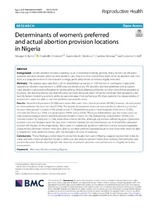| dc.contributor.author | Byrne, Meagan E | |
| dc.contributor.author | Omoluabi, Elizabeth | |
| dc.contributor.author | OlaOlorun, Funmilola | |
| dc.date.accessioned | 2021-12-10T10:42:43Z | |
| dc.date.available | 2021-12-10T10:42:43Z | |
| dc.date.issued | 2021 | |
| dc.identifier.citation | Byrne, M. E., Omoluabi, E., OlaOlorun, F. M., Moreau, C., & Bell, S. O. (2021). Determinants of women’s preferred and actual abortion provision locations in nigeria. Reproductive Health, 18(1) doi:10.1186/s12978-021-01290-w | en_US |
| dc.identifier.uri | doi:10.1186/s12978-021-01290-w | |
| dc.identifier.uri | http://hdl.handle.net/10566/7068 | |
| dc.description.abstract | Background: Unsafe abortion remains a leading cause of maternal mortality globally. Many factors can infuence
women’s decisions around where to seek abortion care; however, little research has been done on abortion care decisions at a population-level in low-resource settings, particularly where abortion is legally restricted.
Methods: This analysis uses data from a 2019–2020 follow-up survey of 1144 women in six Nigerian states who
reported an abortion experience in a 2018 cross-sectional survey. We describe women’s preferred and actual primary abortion care provider/location by distinguishing clinical, pharmacy/chemist, or other non-clinical providers or
locations. We also examine factors that infuence women’s decisions about where to terminate their pregnancy and
identify factors hindering women’s ability to operationalize their preferences. We then examine the characteristics of
women who were not able to use their preferred provider/location.
Results: Non-clinical providers (55.0%) were more often used than clinical providers (45.0%); however, clinical providers were preferred by most women (55.6%). The largest discrepancies in actual versus preferred abortion provider/
location were private hospitals (7.6% actual versus 37.2% preferred), government hospitals (4.3% versus 22.6%),
chemists (26.5% versus 5.9%) and pharmacies (14.9% versus 6.6%). “Privacy/confdentiality” was the most common
main reason driving women’s abortion provider/location choice (20.7%), followed by “convenience” (16.9%) and
“recommended” by someone (12.3%), most often a friend (60.8%), although top reasons difered by type of provider/
location. Cost and distance were the two most common reasons that women did not use their preferred provider/
location (46.1% and 21.9%, respectively). There were no statistically signifcant diferences in the sociodemographic
characteristics between women who were able to use their preferred provider/location and those who were not able
to implement their preferred choice, with the exception of state of residence.
Conclusions: These fndings provide insights on barriers to abortion care in Nigeria, suggesting discretion is key to
many women’s choice of abortion location, while cost and distance prevent many from seeking their preferred care
provider/location. Results also highlight the diversity of women’s abortion care preferences in a legally restrictive
environment. | en_US |
| dc.language.iso | en | en_US |
| dc.publisher | Springer | en_US |
| dc.subject | Abortion | en_US |
| dc.subject | Decision-making | en_US |
| dc.subject | Nigeria | en_US |
| dc.title | Determinants of women’s preferred and actual abortion provision locations in Nigeri | en_US |
| dc.type | Article | en_US |

